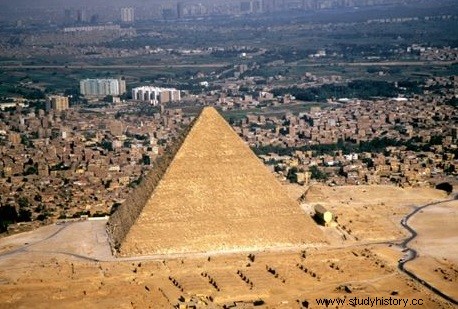 The Great Pyramid of Cheop s in Egypt is the most gigantic construction of antiquity and the only one of the Seven Wonders of the world still existing. Alongside the pyramids of Chephren and Mykerinos, the massive pyramid of Cheops, the largest of the Giza group, reached 147 meters in height and its orientation deviated only 5’30” from the geographic north. It appears today deprived of its external coating (removed by the Arabs to be used as construction material) and of its summit (pyramidion). Its height is therefore only about 137 meters. This monumental tomb had the function of preserving the immortality of the king, a successful bet since the name of Cheops has crossed the centuries until today.
The Great Pyramid of Cheop s in Egypt is the most gigantic construction of antiquity and the only one of the Seven Wonders of the world still existing. Alongside the pyramids of Chephren and Mykerinos, the massive pyramid of Cheops, the largest of the Giza group, reached 147 meters in height and its orientation deviated only 5’30” from the geographic north. It appears today deprived of its external coating (removed by the Arabs to be used as construction material) and of its summit (pyramidion). Its height is therefore only about 137 meters. This monumental tomb had the function of preserving the immortality of the king, a successful bet since the name of Cheops has crossed the centuries until today.
The Giza site
The silhouettes of the three pyramids of Giza, dating from the Fourth Dynasty, loom on the horizon as soon as you pass the suburbs of Cairo (which gave its name to the site ), going southwest along Avenue des Pyramides. The history of the site goes back a long way, that is to say at least to the reign of King Ninetjer of the 2nd dynasty, whose name can be read on the caps of jars discovered in a tomb in the southern part of the site. An even older tomb, dating from the reign of Wadji (king of the 1st dynasty), was to the south of the area usually described as the necropolis of Giza.
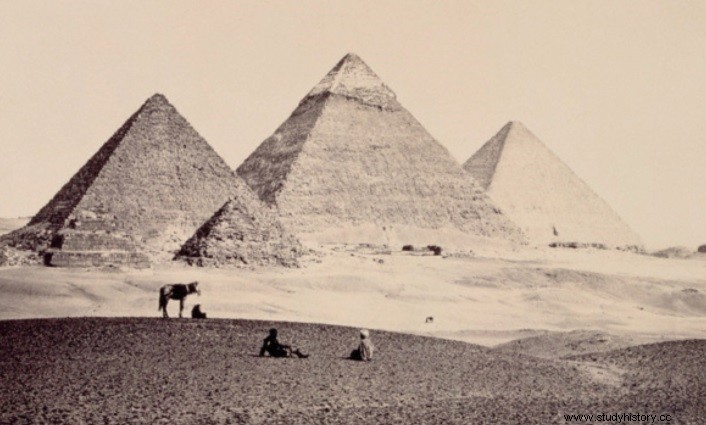 The present appearance of the site is the combined result of the natural configuration of the ground and the activity of the man, in particular from the exploitation of local limestone rich in fossils which was used as building material, as well as from the leveling due to the dumping of construction spoil. The exploitation of the quarries is more particularly visible to the south-east of the pyramids of Chephren and Menkahouher.
The present appearance of the site is the combined result of the natural configuration of the ground and the activity of the man, in particular from the exploitation of local limestone rich in fossils which was used as building material, as well as from the leveling due to the dumping of construction spoil. The exploitation of the quarries is more particularly visible to the south-east of the pyramids of Chephren and Menkahouher.
The site comprises two well-defined groups, located on a plateau and separated naturally by the width of a wadi. The first unit, which is the largest and most important, has the pyramids and the private mastabas that surround them. The temples of the valley belonging to the pyramids, as well as the great Sphinx with the adjoining temples, are located at the bottom of the plateau. The less important group comprises only private tombs and is located on a hill to the south-east.
Systematic study of the site began in the first half of the 19th century. Among the very first explorers, the most eminent were Caviglia, Belzoni, Vyse and Perring. Lepsius and the Prussian expedition worked there in the early 1840s. Mariette and Petrie in turn became interested in it in the second half of the last century and at the beginning of ours. Reisner, Junker and Selim Hassan made a decisive contribution to the study of Giza. Although this place has been more systematically excavated than any other site in Egypt, its exploration still cannot be considered complete.
The Cheops pyramid and its ensemble
The pyramid of Cheops, usually called the Great Pyramid, is one of the most famous monuments in the world (it was one of the "seven wonders of the world" for the Elders). Its gigantic dimensions and the perfection of its construction have attracted travelers to the Memphis area since time immemorial. The pyramid must have lost its original treasures during the period of political instability and social unrest that followed the collapse of central power after the end of the Old Kingdom, but we do not have the formal proof.
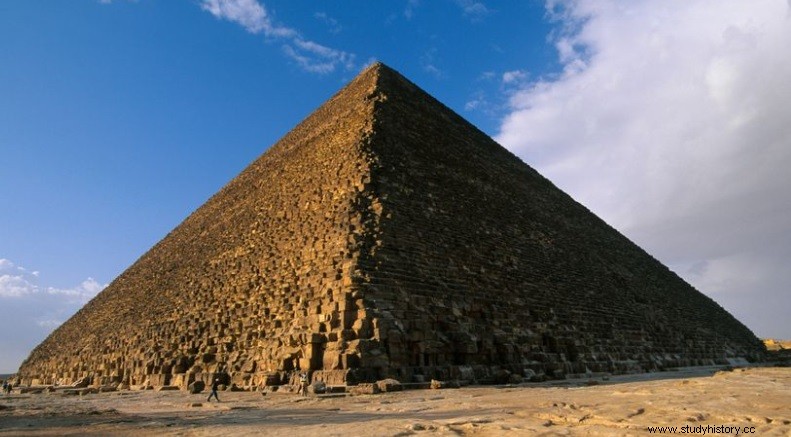 The reuse of decorated blocks from the building began in Licht during the reign of Amenemhat I. Modern explorers have found the Great Pyramid empty except for massive granite sarcophagi in the third-plane burial chamber, which proves its original purpose. In the Middle Ages, the exterior limestone cladding was completely removed, especially to build buildings in Giza and Cairo. If we put aside the small pyramids of the wives of Cheops, it is today the only element of the original set which is indisputable and which seems little touched, despite all the looting.
The reuse of decorated blocks from the building began in Licht during the reign of Amenemhat I. Modern explorers have found the Great Pyramid empty except for massive granite sarcophagi in the third-plane burial chamber, which proves its original purpose. In the Middle Ages, the exterior limestone cladding was completely removed, especially to build buildings in Giza and Cairo. If we put aside the small pyramids of the wives of Cheops, it is today the only element of the original set which is indisputable and which seems little touched, despite all the looting.
The Valley Temple is buried somewhere below the current village of Naslet el-Semman; we therefore do not see how it could be released in the near future. The causeway, indicated on old maps, and still visible in the last century, also disappeared when the modern village expanded. Only a fragment of basalt paving, near the eastern face of the pyramid, indicates the position of the temple which accompanied it. Cheops may not have succeeded in securing his remains for eternity, but he did at least achieve a virtually indestructible monument.
The interior of the Great Pyramid shows that the initial plan underwent at least two modifications during construction. When you enter the pyramid through an opening forced by the men of Caliph Al Mamoun in the 9th century AD. AD, opening which is located below the original entrance and a little to the west of it, we find ourselves in a descending corridor. This leads to the burial chamber in the foreground, which is below ground level. Before being completed, this room was enlarged and modified with a view to creating the burial chamber of the second level:being in the very mass of the pyramid, it can be reached by an ascending corridor and a level gallery. Another modification of the plans also caused this room to be abandoned, the ascending gallery being extended by the large corridor which leads to the burial chamber of the third plan.
This large gallery, with its high corbelled ceiling, is the most remarkable part of the interior. It was also to be used to store the blocks of granite intended to be poured into the ascending corridor to block it definitively. It is not difficult to guess the various changes of plans, if one realizes that the architects must have completed their task at the death of the pharaoh:however, who could have foreseen the date?
The construction of the Cheops pyramid:a mystery?
Even today, the construction of the Great Pyramid would cause considerable problems in the direction and execution of the work. The project must have been more or less completed by the end of the twenty-third year of the reign of Cheops (around 2560 BC). Its construction required 100,000 large blocks each year (i.e. approximately 285 per day) each weighing an average of two and a half tons, which had to be extracted, roughed out, transported to the site and placed in place. As construction progressed, the height to which the blocks had to be raised increased, while the platform available to work on decreased rapidly. When the monument had reached a certain height, the transport of materials was certainly carried out only by hand, since the lack of space must have prevented the use of beasts of burden.
However, such simple devices as the pulley and the wheeled cart had not yet been invented, and huge blocks of stone had to be moved and hoisted. So we probably built, with a lot of manpower, ramps to weave the blocks and bring everything that was necessary to the workplace. But since there is no certainty about the methods used, we are reduced to conjectures for the work carried out by the workers. The scale of the task, the care with which the building was designed and built, and the fact that no burial has ever been found in the Great Pyramid pose problems that have not yet been resolved; it would indeed be absurd if all this work had been done for one man, and moreover for nothing. Many assumptions have been made about the true purpose of the Great Pyramid.
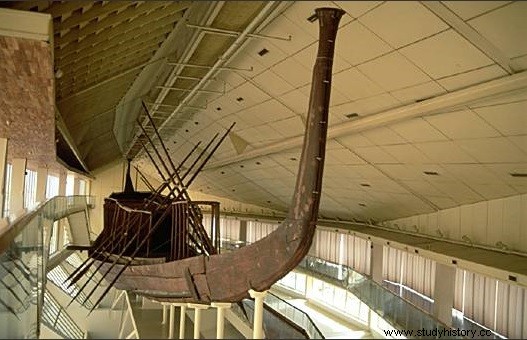 A remarkable discovery was made in the early 1950s:a rectangular pit near the southern face of the pyramid of Cheops, containing the dismantled remains of a large boat. These vestiges, due to the confinement of the air, were very well preserved, and the boat, more than 40 m long and displacing about 10 barrels, was reassembled). We know the location of another pit, which certainly contains another boat, but it has not yet been opened. The boats may have been used to bring the body of the deceased pharaoh across the Nile, from his palace somewhere on the eastern bank to the place of purification and embalming, and finally to the temple in the valley.
A remarkable discovery was made in the early 1950s:a rectangular pit near the southern face of the pyramid of Cheops, containing the dismantled remains of a large boat. These vestiges, due to the confinement of the air, were very well preserved, and the boat, more than 40 m long and displacing about 10 barrels, was reassembled). We know the location of another pit, which certainly contains another boat, but it has not yet been opened. The boats may have been used to bring the body of the deceased pharaoh across the Nile, from his palace somewhere on the eastern bank to the place of purification and embalming, and finally to the temple in the valley.
Esoteric interpretations of the pyramids
The first "mystical theory" was formulated in 1859 by a certain J. Taylor who asserted that only a people inspired by God, and not the idolatrous Egyptians, could have built the pyramids . Relying on a misinterpretation of texts by ancient historians, he came to the conclusion that the chosen people had invaded Egypt and built these buildings under the direction of Shem, one of the sons of Noah, or perhaps of the mysterious king-priest Melchizedek. This theory was taken up and developed by the astronomer Piazzi Smith (nicknamed "Pyramidot") who arbitrarily fixed a basic unit of measurement, the "pyramidal inch", which made it possible to find in the dimensions of the rooms and interior passages of the Great Pyramid the dates of all events and prophecies mentioned in the Old and New Testaments.
Other supporters of mystical theories attributed these achievements to a clergy of initiates, holders of a mysterious science whose trace would be found in the religious texts known under the title of Book of the dead. This would therefore not be a collection of formulas intended to ensure a happy existence in the afterlife, but a symbolic account of the trials that the initiate must face in order to achieve immortality. There were also "scientific" theories, mainly inspired by the discovery of two surprising characteristics of the pyramids:their almost perfect orientation and the harmony of their proportions.
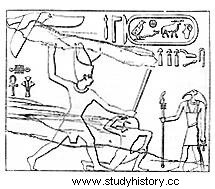 Proclus, a Greek philosopher of the 5th century AD, had already claimed that these buildings had been built to serve as astronomical observatories. We end up seeing in the Great Pyramid a sundial indicating the different seasons by means of the shadows it cast, and by supposing that the first part of the construction, including the large gallery, had been used for astronomical purposes before being transformed into a pyramid-shaped tomb.
Proclus, a Greek philosopher of the 5th century AD, had already claimed that these buildings had been built to serve as astronomical observatories. We end up seeing in the Great Pyramid a sundial indicating the different seasons by means of the shadows it cast, and by supposing that the first part of the construction, including the large gallery, had been used for astronomical purposes before being transformed into a pyramid-shaped tomb.
In Germany and Western Europe, "mathematical" theories also appeared. Starting from the questionable interpretation of the Histories of Herodotus made by a certain Abbé Moreux, it was argued that the Egyptians knew the golden number, which allows architecture to obtain the most harmonious proportions.
To go further
- The Great Pyramid of Cheops:New Discoveries. Editions du Rocher, 2006.
- The Secret of the Builders of the Great Pyramids:Cheops, by Georges Goyon. Pygmalion, 1997.
